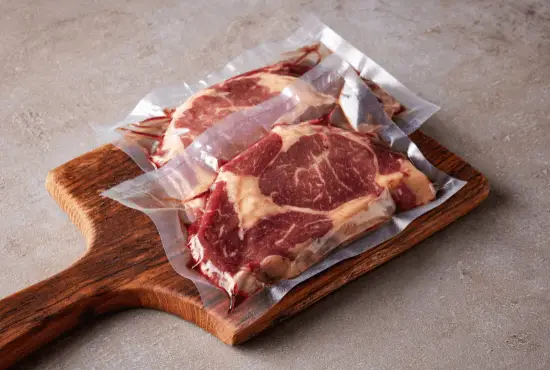Do you prefer vacuum-sealing your meat as it is less likely to become oxidized and discolored? But what about freezing it again after thawing. Will it remain tender and juicy?
Refreezing is a complicated process, and you might hesitate to place your meat back in the freezer as it is in a delicate state. We are here today to uncover this myth for you and let you discover, can you refreeze vacuum-sealed meat?
You can refreeze different meat kinds after vacuum-sealing them in bags/containers. If you leave it to thaw in the fridge, it will refreeze for five to six months without turning rancid. Ensure to check and seal the meat properly when you finally twice freeze it. You can also opt for heavy-duty freezer bags to maintain freshness. Avoid letting it sit at room temperature for a longer span.
Before you start to refreeze the meat, there are certain aspects that you need to know. It is crucial to perform the procedure with the correct technique. Else, all the blood and sweat you put into it will waste away. Let’s discover together the pros and cons of refreezing sealed meat.
Table of Contents
Refreezing Vacuum Sealed Meat; Is It Safe?
When it comes to keeping your meat for long-term storage, vacuum sealing is the most effective option. It prevents the formation of ice crystals, and it remains tender for a decent amount of time. Vacuum sealing removes most of the excess air from the packaging that can cause the food to spoil. It also prevents the build-up of bacteria that can ruin food.
By looking at the benefits, vacuum sealing is a go-to option for many people for bulk storing meat in the freezer. Once you thaw the required amount, you can refreeze without worrying about spoilage. Yes, vacuum-sealed protein freezes, thaws, and freezes again as it has minimal exposure to air contamination.
You might notice a quality loss in the meat, but it is still edible and won’t go to waste. Besides, refreezing requires careful handling. If you keep it at room temperature for longer durations after thawing, it might not be fit for refreezing. So, it is necessary to thaw vacuum-sealed meat in the fridge if you intend to freeze it again.
Can You Refreeze Meat That Is Vacuum-Packed At Home?
Nowadays, many people prefer sealing their food with a vacuum-sealing machine. This method is easy, effective, and provides satisfactory results. When you vacuum-seal meat, it lasts fresh for longer and takes up less space inside the freezer.
Let’s suppose some guests arrive, and you defrost meat in a hurry for preparing a delicious steak. Later you realize the quantity is far more than you require. No worry, you can place the leftover back in the freezer as long as it thaws in the refrigerator. But, if you leave it to defrost on the kitchen counter, the meat might not survive twice freezing.
When the meat comes in contact with air, it is prone to degrade faster due to the spread of bacteria. So, if you seal it properly afterward, it might serve no purpose and will spoil ultimately. Thus, in such a situation, you should toss the meat and drop the idea of refreezing.
Can You Refreeze Meat In Vacuum-Sealed Supermarket Package?
If your store-bought meat comes in vacuum-sealed packaging, you can refreeze it right away and place it directly in the freezer. The packaging design allows it to remain intact in the harsh freezer environment and keep your meat as good as new.
But, in case you have already opened the packaging, you can still refreeze the meat. Ensure to wrap it in a high-quality freezer bag to protect it from forming ice crystals. Also, if your meat thaws on the way back home, transfer it immediately to the freezer without delay.
When the meat stays in the open environment for more than two hours, bacteria might start lurking inside, and it is no longer safe for storage. The vacuum-sealed packaging can slow down the spread to some degree, but it is still on the verge of spoilage.
Thus, you need to thoroughly check the meat to observe a change in the smell and texture. If you notice such changes, it is better to discard them immediately.
The Right Method To Refreeze Vacuum-Sealed Meat
If you decide to refreeze the meat that you vacuum sealed before, all you need to do is
- Gently take the meat out from its vacuum packing. As vacuum-sealed beef usually comes in large, folded packages, it might stick with the packaging.
- Avoid causing any damage to the packaging as you will require it later on for storing the meat.
- Once you remove the vacuum seal, wrap the meat in aluminum foil or plastic wrap.
- Cover and fold all the edges securely and put the meat back in the original packaging.
- The additional layer of protection will prevent the meat from getting freezer burns and keep it fresh for a longer span.
- You can directly refreeze the store-bought meat if the packaging was unopened previously. If it is open, you need to cover it in freezer bags.
- Ensure to label the bag with the date of refreezing and place it in the safest corner of the freezer. It will remain there for as long as you prefer.
How Long Can Meat Remain Refrozen After Vacuum Sealing?
Although vacuum-sealing your meat is an effective way to increase its shelf life and keep it fresh and flavorful. But, to achieve the desired results, you need to consider a few things. Firstly, it is vital to thaw the meat in the refrigerator, not other techniques. The fridge provides a safe environment for the meat and reduces the chances of air contamination.
If you thaw vacuum-sealed meat in a refrigerator, it will refreeze with ease for more than five months. Other methods, including thawing on the counter, cold water, or a microwave, do not complement the refreezing process. Even if the meat is in vacuum packaging, there is still a high probability it spoils after freezing, and your efforts go to waste.
Secondly, leaving your raw/cooked meat at room temperature is like inviting the microbes to infest it, and you do not want it to happen. So, to avoid the outcome of unnecessary food wastage, shift the meat to the freezer after thawing as quickly as possible.
How Many Times Can You Refreeze Vacuum-Sealed Meat?
Generally, people prefer sealing their protein-based food for long-term storage, and the same rule applies to your meat.
If you regularly thaw and freeze it, the benefits of vacuum-sealing get limited.
No matter how cautious you are, there is still a chance of contamination. Thus, once you refreeze vacuum-sealed meat, avoid doing it again. Besides the food safety problem, there is also a noticeable degradation in the overall quality.
Food safety and inspection authorities do not recommend freezing meat repeatedly, even if vacuum-sealed. A much better alternative is to freeze it in portions according to your requirement and thaw only that specific amount. It will save time and also reduce the occurrence of spoilage.
Conclusion
To sum up, you can refreeze meat that you store in vacuum-sealed bags. As vacuum sealing food means removing the excess air, it minimizes the chances of spoilage. Thus, refreezing meat is a safe option, but you need to thaw the meat in the refrigerator.
Other defrosting methods do not go well with the refreezing process. For instance, if you thaw meat by running hot water over it, freezing it again is not ideal. To yield the exact results you are looking for, follow all the mentioned steps in this article and do not skip them.
Refreezing can alter the tenderness of the meat and turn it somewhat bland and chewy. Thus, it is better to avoid constant thawing and freezing. Also, always check if you sealed food properly, or else it might be prone to freezer burns and loss of flavors.
Freezing is a great way to prevent leftovers from wastage and maintain the cleanliness of the environment.



